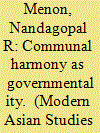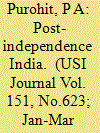|
|
|
Sort Order |
|
|
|
Items / Page
|
|
|
|
|
|
|
| Srl | Item |
| 1 |
ID:
139676


|
|
|
|
|
| Summary/Abstract |
Debates about secularism in post-independence India have often revolved around the visions of two of the country’s founding fathers—M.K.Gandhi and Jawaharlal Nehru. A sharp distinction is drawn between them by those who argue that the Gandhian model (or, what in common parlance and state discourses is called communal harmony) stems from Indian cultural and religious values, and lies beyond the realm of the state. The Nehruvian model, however, is a state project through and through. This article transcends this dichotomy to show that
the association of Nehru and Gandhi with these models does not necessarily mean that secularism and communal harmony faithfully reflect their ideas and, despite the differences in their aims and methods, both models are united in the discourses and practices of the state as strategies of ‘governmentality’. After redefining the core of communal harmony as reciprocity (rather than tolerance), I show how it is performed, how it supplements the state’s efforts to keep the peace in a religiously plural society by the force of law, and shores up the state’s
legitimacy deficit. However, the state’s simultaneous involvement in Nehruvian and Gandhian projects is not an innocuous fact because it undermines the state’s constitutional and secular obligations to non-discriminatory citizenship in the Indian nation. The argument is that the state’s endorsement of dargah-centred Islamic piety as an exemplary site of communal harmony and particular ideas of the Indian nation legitimized by communal harmony ‘problematizes’ the national belonging of certain kinds of pious Muslims.
|
|
|
|
|
|
|
|
|
|
|
|
|
|
|
|
| 2 |
ID:
179359


|
|
|
|
|
| Summary/Abstract |
The issue of jointmanship in the Indian Armed Forces assumed greater salience with Revolution in Military Affairs (RMA) and enhanced threats including collusive ones. Although unanimously agreed as a necessity, the perceptions about jointmanship vary across the Services. Analysis of jointmanship exhibited during wars, conflicts and major operations reveals a mixed bag — mainly divergent at the military strategic level yet reasonably good coherence, coordination and execution at the tactical level. To jointly outfight the enemy, the article infers the need of establishing sound Civil-Military Relations (CMR), realistic threat assessment, enhancing joint training, jointly developing capabilities, and rejuvenating existing mechanisms, especially at the strategic level. Importantly, it highlights the difference good leadership and a robust Professional Military Education (PME) makes in enhancing jointness, both in peace and war.
|
|
|
|
|
|
|
|
|
|
|
|
|
|
|
|
|
|
|
|
|